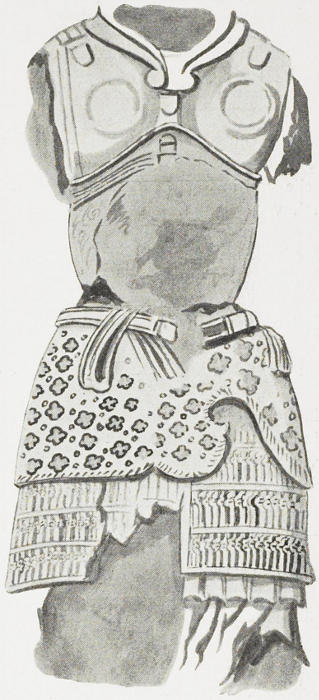
Shop Amazon - Create an Amazon Baby Registry
Carved Armoured Figure, Naga Cave,
Sorcuq (between Kucha & Turfan), Tarim Basin

|
Höhle 8, Höhle der Nâgas1 ... Beim Ausräumen der Höhle wurde eine »Clayfigur« eines gepanzerten Lokapâla (Fig. 460), doch ohne Kopf und ohne Extremitäten, gefunden, außerdem Stücke der übrigen und viele in Farben wundervoll abgestufte Blätter der Lotusblumen, auf welchen die Statuen gestanden hatten. Auch fand sich ein unbärtiger Kopf. Die am besten erhaltene Statue zeigt einen Panzer in altjapanischem Stil mit niedrigem Kragen, Brustplatten mit Ringornamenten, einer mit bunten Ornamenten prachtvoll bemalten Bauchberge, welche bis zur Herzgrube reicht und die Brustplatten andrückt. Daran schließt sich eine bis zum Knie reichende Panzerschürze, zusammengesetzt aus mehreren Streifen einzeln aufgereihter, bunt bemalter Metallplättchen. Über dieser Schürze hängt ein Pantherfell, von einem Gürtel gehalten. Die darunter hervortretenden Gewandteile sind in wundervoller Ornamentik (Blumenranken) bemalt. Der Stil ist identisch mit Höhle 14 (Haupttal, von Ming-Öi beim Qumtura). 1 An Ort und Stelle so benannt wegen der zahlreichen Nâgaabbildungen auf dem Gewölbe, welche, so lange die Höhle noch nicht ausgeräumt war, zunächst auffielen. |
Cave 8, Nagas’ Cave1 ... While clearing the cave, a "clay figure" of an armoured Lokapala (Fig. 460), but without a head and without extremities, was found, as well as pieces of the rest and many wonderfully coloured leaves of the lotus flowers on which the statues had stood. There was also a bearded head. The best preserved statue shows an armour in the old Japanese style with a low collar, breast plates with ring ornaments, a plackart, which is magnificently painted with colourful ornaments, which extends to the sternum and overlaps the breastplates. This is followed by an armoured apron reaching to the knee, composed of many strips of, brightly painted, individually lined up, metal plates. A panther skin hangs over this apron, held by a belt. The parts of the garment protruding below are painted in wonderful ornamentation (floral tendrils). The style is identical to cave 14 (Main valley, of Ming-oi near Kumtura). 1 So named on the spot because of the numerous naga images on the vault, which were initially noticeable as long as the cave had not been cleared. |